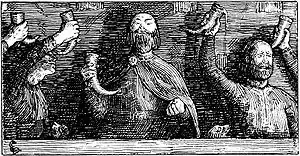Dyggvi
Dyggvi o Dyggve (nórdico antiguo: Útil o Efectivo[1]) fue un rey legendario de Suecia de la Casa de Yngling.[2][3] En el contexto mitológico de su figura legendaria, a su muerte se convirtió en marido de Hela, hija de Loki, reina de Niflheim (inframundo). Le sucedió su hijo Dag el Sabio. Su figura protohistórica aparece en la saga Ynglinga,[4] Ynglingatal[5] e Historia Norwegiæ.[6][7]
| Dyggvi | ||
|---|---|---|
 | ||
| Información personal | ||
| Nacimiento | Siglo II | |
| Fallecimiento |
Siglo III Gamla Uppsala (Suecia) | |
| Familia | ||
| Padre | Domar | |
| Cónyuge | Hela | |
| Hijos | Dag el Sabio | |
| Información profesional | ||
| Ocupación | Político | |
| Cargos ocupados | Rey semilegendario de Suecia | |
La saga Ynglinga de Snorri Sturluson habla sobre el rey Dyggvi de Suecia:
- La madre de Dyggvi era Drótt, hija del rey Danp, hijo de Ríg, el primero a quien llamaron konungr ['rey'] el la lengua de los daneses [nórdico antiguo]. Sus descendientes siempre conservaron el título konungr como la más alta dignidad. Dyggvi fue el primero en su familia que se hizo llamar konungr, sus predecesores se hacían llamar dróttinn ['caudillo'], y sus esposas dróttning, y su corte drótt ['banda de guerra']. Todos los de su estirpe se llamaron Yngvi, or Ynguni, y todos los de su dinastía Ynglingar. La reina Drótt era hermana del rey Dan Mikilláti, de quien Dinamarca tomó su nombre.
Íslendingabók cita una línea de descendencia en Ynglingatal y menciona a Dyggvi como sucesor de Dómarr y predecesor de Dag el Sabio: ix Dómarr. x Dyggvi. xi Dagr.[8]
Referencias
- McKinnell, John (2005). Meeting the Other in Norse Myth and Legend. DS Brewer. ISBN 1843840421 p. 70.
- The Viking Age: the Early History, Manners, and Customs of the Ancestors of the English-speaking Nations: Illustrated from the Antiquiites Discovered in Mounds, Cairns, and Bogs as Well as from the Ancient Sagas and Eddas, Du Chaillu, Paul B. (Paul Belloni), (2 volumes. London : John Murray, 1889), FHL book 948 H2d; FHL film 1440113 items 1-2., vol. 1 p. 67.
- Der Europäischen käyser- und königlichen Häuser historische und genealogische Erläuterung (1730-1731), Lohmeier, Georg von, und Johann Ludwig Levin Gebhardi, (3 volumes in 1. Luneburg: Sternischen Buchdruckerei, 1730-1731), FHL microfilm 1,051,694, items 4-6., pt. 1 p. 137.
- Heimskringla: or the Lives of the Norse Kings, Sturluson, Snorri, (Cambridge, [Inglaterra]: W. Heffer & Sons Ltd, 1932), FHL book 948 H2sa., p. 21.
- Ynglingatal online
- Storm, Gustav (editor) (1880). Monumenta historica Norwegiæ: Latinske kildeskrifter til Norges historie i middelalderen, Monumenta Historica Norwegiae (Kristiania: Brøgger), p. 98
- Ekrem, Inger (editor), Lars Boje Mortensen (editor) y Peter Fisher (trad.) (2003). Historia Norwegie. Museum Tusculanum Press. ISBN 8772898135, p. 75.
- Íslendingabók ed. Guðni Jónsson
Bibliografía
- Nerman, B. Det svenska rikets uppkomst. Stockholm, 1925.
- Sturluson, Snorri; Lee M. Hollander (1964). Heimskringla: History of the Kings of Norway Lee Hollander. Austin: Published for the American-Scandinavian Foundation by the University of Texas Press. ISBN 0292730616.
Enlaces externos
- La Saga de los Ynglings y la Heimskringla en «Kulturformidlingen norrøne tekster og kvad». (en inglés y noruego)
| Predecesor: Domar |
Reyes legendarios de Suecia Casa de Yngling |
Sucesor: Dag el Sabio |
Este artículo ha sido escrito por Wikipedia. El texto está disponible bajo la licencia Creative Commons - Atribución - CompartirIgual. Pueden aplicarse cláusulas adicionales a los archivos multimedia.